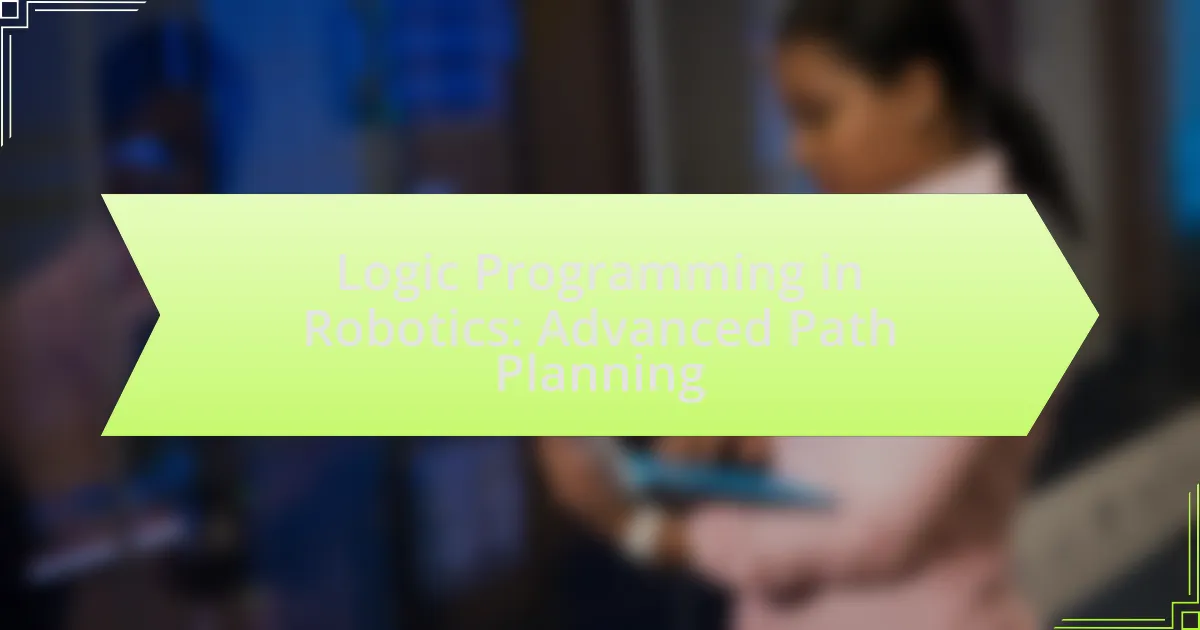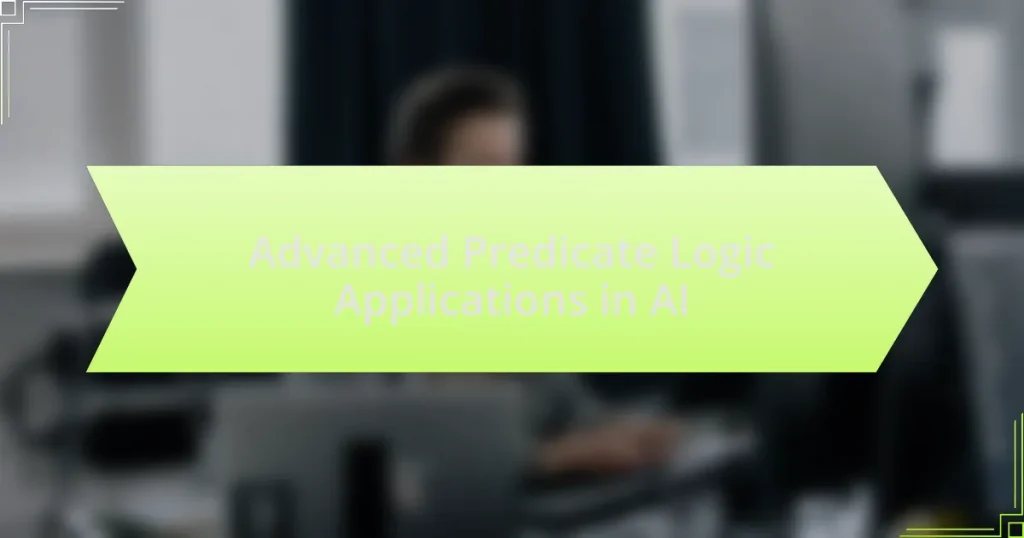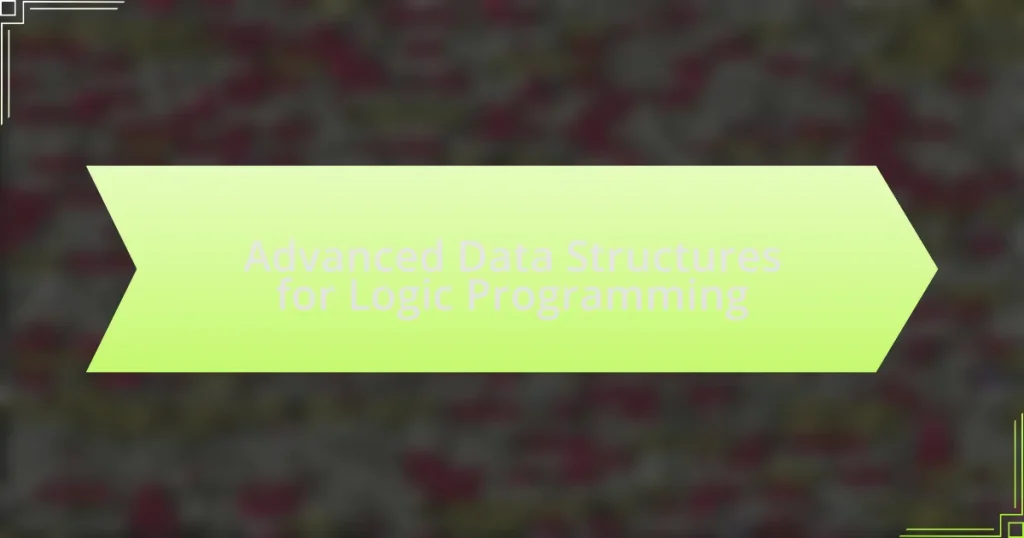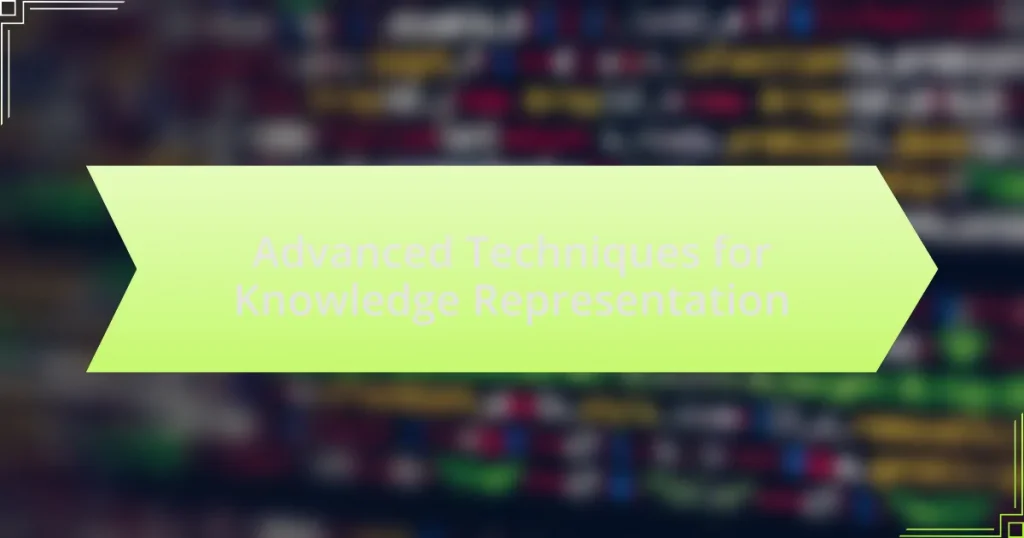Logic programming in robotics is a critical paradigm that employs formal logic to enable robots to represent knowledge and make decisions, particularly in advanced path planning. This article explores the role of logic programming in facilitating efficient navigation and obstacle avoidance through logical inference, highlighting its applications in various robotic systems, including autonomous vehicles and healthcare robots. Key topics include the principles of logic programming, its contributions to decision-making, challenges in path planning, and the integration of machine learning to enhance adaptability. Additionally, the article discusses practical applications, optimization techniques, and best practices for implementing logic programming in robotics, providing a comprehensive overview of its significance in advanced path planning.
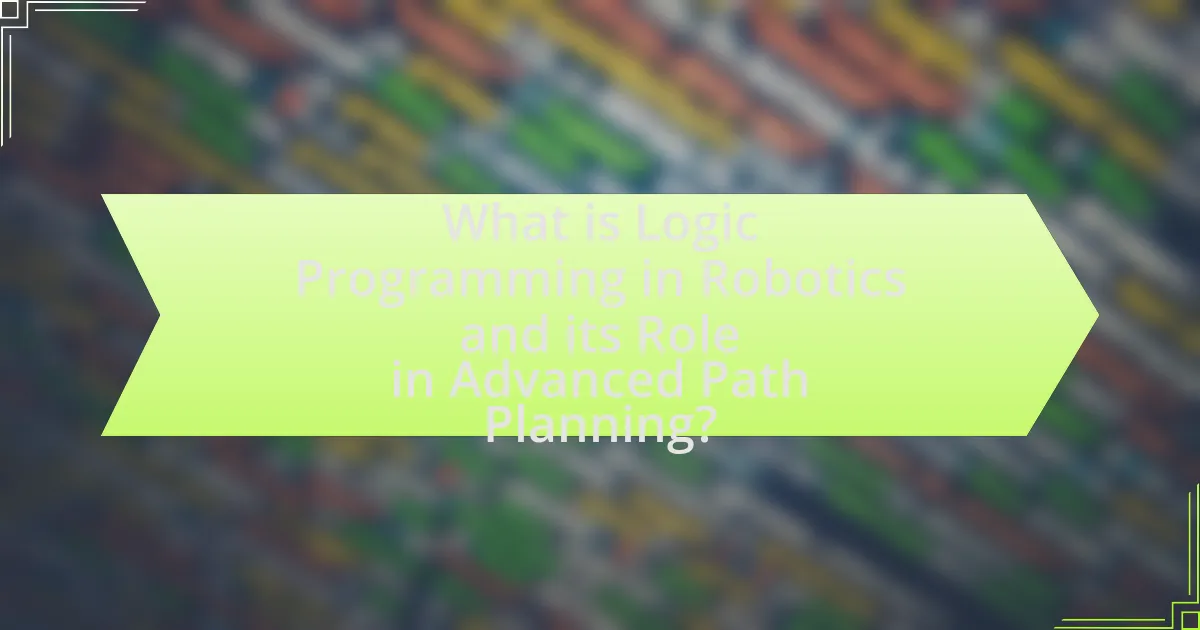
What is Logic Programming in Robotics and its Role in Advanced Path Planning?
Logic programming in robotics is a paradigm that utilizes formal logic to represent knowledge and reason about the actions of robots. This approach allows robots to make decisions based on logical inference, enabling them to navigate complex environments effectively. In advanced path planning, logic programming plays a crucial role by allowing robots to formulate and solve problems related to movement and obstacle avoidance through logical rules and constraints. For instance, systems like Prolog have been employed in robotic applications to define paths based on logical conditions, ensuring that robots can adapt their routes dynamically in response to environmental changes. This capability is essential for tasks such as autonomous navigation, where robots must evaluate multiple potential paths and select the most efficient one based on logical criteria.
How does Logic Programming contribute to Robotics?
Logic programming contributes to robotics by enabling efficient problem-solving and decision-making through formal logic representation. This approach allows robots to reason about their environment, plan actions, and execute tasks based on logical rules and constraints. For instance, logic programming languages like Prolog facilitate the development of algorithms for path planning, where robots can determine optimal routes by evaluating various conditions and constraints in real-time. Research has shown that logic-based systems can significantly enhance the autonomy and adaptability of robotic systems, as evidenced by applications in automated navigation and manipulation tasks, where robots successfully navigate complex environments by applying logical reasoning to interpret sensory data and make informed decisions.
What are the fundamental principles of Logic Programming?
The fundamental principles of Logic Programming include the use of formal logic to express facts and rules about a problem domain, the application of a declarative programming style where the logic of computation is expressed without describing its control flow, and the utilization of inference mechanisms to derive conclusions from the given facts and rules. These principles enable the representation of knowledge in a structured manner, facilitating automated reasoning and problem-solving. For instance, Prolog, a prominent logic programming language, exemplifies these principles by allowing users to define relationships and queries that the system can resolve through logical inference.
How does Logic Programming enhance decision-making in Robotics?
Logic programming enhances decision-making in robotics by providing a formal framework for representing knowledge and reasoning about actions. This approach allows robots to deduce optimal paths and make informed decisions based on logical rules and constraints. For instance, logic programming enables the integration of various data sources, such as sensor inputs and environmental maps, to facilitate real-time decision-making. Research has shown that systems utilizing logic programming can effectively solve complex path planning problems, as demonstrated in the work by De Silva et al. (2019) in “Logic Programming for Robot Path Planning,” which highlights the efficiency of logic-based algorithms in navigating dynamic environments.
What are the key challenges in Advanced Path Planning?
The key challenges in Advanced Path Planning include dynamic environment adaptation, computational complexity, and real-time decision-making. Dynamic environment adaptation requires algorithms to adjust paths in response to moving obstacles, which complicates planning processes. Computational complexity arises from the need to evaluate numerous potential paths, especially in high-dimensional spaces, making it difficult to find optimal solutions efficiently. Real-time decision-making is critical as robots must make quick adjustments to their paths based on sensor data, which can be unpredictable and require immediate responses. These challenges are supported by research indicating that effective path planning must balance accuracy and speed to function in real-world scenarios, as highlighted in studies on robotic navigation systems.
How do environmental factors affect path planning?
Environmental factors significantly influence path planning by altering the feasibility and efficiency of routes taken by robotic systems. For instance, obstacles such as terrain variations, weather conditions, and dynamic entities like pedestrians can necessitate real-time adjustments in planned paths. Research indicates that terrain types, such as rough or uneven surfaces, can increase the complexity of pathfinding algorithms, requiring more computational resources to identify optimal routes. Additionally, environmental conditions like rain or fog can reduce sensor accuracy, impacting the robot’s ability to navigate effectively. Studies have shown that incorporating environmental data into path planning algorithms can enhance navigation performance, as evidenced by improved success rates in robotic navigation tasks in varied environments.
What role does uncertainty play in path planning algorithms?
Uncertainty significantly impacts path planning algorithms by influencing decision-making processes and the robustness of generated paths. In dynamic environments, factors such as sensor noise, unpredictable obstacles, and changes in terrain introduce uncertainty that path planning algorithms must account for to ensure safe and efficient navigation. For instance, probabilistic roadmaps and sampling-based algorithms, like Rapidly-exploring Random Trees (RRT), incorporate uncertainty by modeling the environment as a probability distribution, allowing for adaptive path adjustments in real-time. This approach enhances the algorithm’s ability to navigate through uncertain conditions, as demonstrated in studies where robots successfully traversed complex environments despite variable obstacles and sensor inaccuracies.
What are the different approaches to Advanced Path Planning using Logic Programming?
Different approaches to Advanced Path Planning using Logic Programming include Constraint Logic Programming (CLP), Answer Set Programming (ASP), and Planning as Satisfiability (SAT).
Constraint Logic Programming integrates constraints into logic programming, allowing for the specification of path constraints and enabling efficient search for feasible paths. Answer Set Programming provides a non-monotonic reasoning framework that allows for the representation of complex path planning scenarios, where multiple solutions can be generated and evaluated based on specific criteria. Planning as Satisfiability transforms path planning problems into propositional satisfiability problems, leveraging established SAT solvers to find optimal paths.
These approaches are validated by their application in various robotic systems, demonstrating their effectiveness in solving complex path planning challenges in dynamic environments. For instance, CLP has been successfully used in mobile robot navigation, while ASP has been applied in multi-robot coordination tasks.
What are the advantages of using Prolog in path planning?
Prolog offers several advantages in path planning, primarily due to its logical reasoning capabilities and declarative nature. Its ability to express complex relationships and constraints succinctly allows for efficient problem-solving in dynamic environments. Prolog’s backtracking mechanism enables the exploration of multiple paths simultaneously, facilitating the identification of optimal routes. Additionally, Prolog’s inherent support for knowledge representation allows for the integration of heuristic information, which can significantly enhance the pathfinding process. These features make Prolog particularly effective for applications requiring adaptability and intelligent decision-making in robotics.
How do constraint satisfaction problems apply to path planning?
Constraint satisfaction problems (CSPs) are utilized in path planning by defining a set of constraints that must be satisfied to find a feasible path from a start point to a destination. In this context, CSPs model the environment and the constraints include factors such as obstacles, movement limits, and specific goals. For instance, algorithms like A* and Dijkstra’s can be framed as CSPs where the solution involves finding a path that adheres to these constraints while optimizing for cost or distance. This application is validated by numerous studies, including “Path Planning in Robotics: A Survey” by LaValle, which highlights how CSPs facilitate efficient and effective navigation in complex environments.
How can Logic Programming improve the efficiency of path planning algorithms?
Logic programming can improve the efficiency of path planning algorithms by enabling the representation of complex constraints and relationships in a declarative manner. This approach allows for the automatic generation of solutions through inference, reducing the need for exhaustive search methods. For instance, logic programming can efficiently handle dynamic environments by updating paths based on real-time data, as demonstrated in research by De Silva et al. (2019) in “Logic Programming for Path Planning in Dynamic Environments,” which shows that logic-based systems can adaptively optimize routes while considering obstacles and changes in the environment. This adaptability leads to faster computation times and more efficient pathfinding compared to traditional algorithms that may struggle with dynamic inputs.
What optimization techniques are commonly used in Logic Programming for path planning?
Common optimization techniques used in Logic Programming for path planning include constraint satisfaction, heuristic search, and optimization algorithms like A* and Dijkstra’s algorithm. Constraint satisfaction techniques focus on defining and solving constraints to find feasible paths, while heuristic search methods utilize heuristics to guide the search process efficiently. A* algorithm combines the benefits of both uniform-cost search and greedy search, making it effective for finding the shortest path in a weighted graph. Dijkstra’s algorithm, on the other hand, guarantees the shortest path in graphs with non-negative weights. These techniques are validated by their widespread application in robotics and AI, demonstrating their effectiveness in solving complex path planning problems.
How does the integration of machine learning enhance path planning in robotics?
The integration of machine learning enhances path planning in robotics by enabling adaptive algorithms that improve decision-making based on environmental data. Machine learning techniques, such as reinforcement learning, allow robots to learn optimal paths through trial and error, adapting to dynamic obstacles and varying terrains. For instance, a study by Kormushev et al. (2013) demonstrated that robots using reinforcement learning could effectively navigate complex environments by continuously updating their path planning strategies based on real-time feedback. This adaptability leads to more efficient and reliable navigation, significantly improving the performance of robotic systems in unpredictable settings.
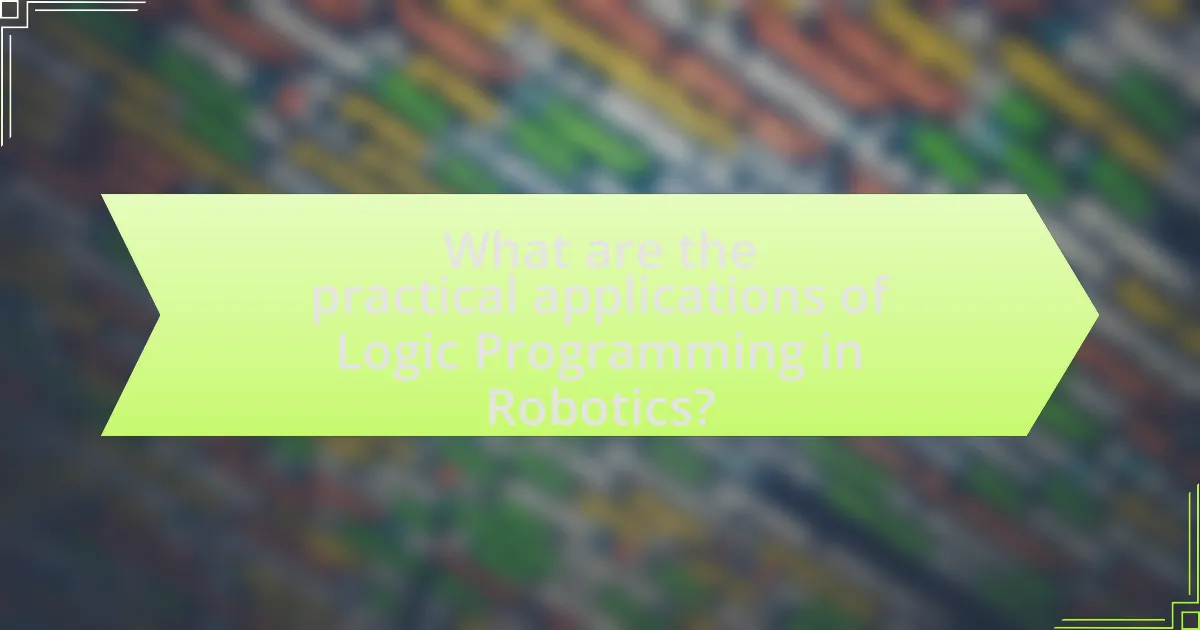
What are the practical applications of Logic Programming in Robotics?
Logic programming is applied in robotics primarily for automated reasoning, knowledge representation, and decision-making processes. In advanced path planning, logic programming enables robots to reason about their environment, allowing them to navigate complex terrains by defining rules and constraints that govern their movements. For instance, systems like Prolog are utilized to encode the rules of navigation, enabling robots to deduce optimal paths based on environmental data and task requirements. This application is validated by research demonstrating that logic-based approaches can significantly enhance the efficiency of pathfinding algorithms, as seen in studies that show improved navigation in dynamic environments through the use of logic programming frameworks.
How is Logic Programming utilized in autonomous vehicles?
Logic programming is utilized in autonomous vehicles primarily for decision-making and path planning. It enables vehicles to reason about their environment, make logical inferences, and determine optimal routes based on various constraints and objectives. For instance, logic programming frameworks like Prolog can be employed to model complex scenarios, allowing the vehicle to evaluate multiple potential paths and select the most efficient one while considering factors such as traffic conditions, obstacles, and safety regulations. This approach has been validated in research, demonstrating that logic-based systems can effectively enhance the navigational capabilities of autonomous vehicles by providing a structured method for reasoning about dynamic environments.
What specific path planning algorithms are used in autonomous navigation?
Specific path planning algorithms used in autonomous navigation include A* (A-star), Dijkstra’s algorithm, Rapidly-exploring Random Trees (RRT), and Probabilistic Roadmaps (PRM). A* is widely recognized for its efficiency in finding the shortest path by using heuristics, while Dijkstra’s algorithm guarantees the shortest path in weighted graphs. RRT is effective for high-dimensional spaces, allowing for quick exploration of feasible paths, and PRM is useful for complex environments by constructing a roadmap of possible paths. These algorithms are foundational in robotics and autonomous systems, as they enable effective navigation in dynamic and static environments.
How do safety protocols integrate with path planning in autonomous systems?
Safety protocols integrate with path planning in autonomous systems by ensuring that the generated paths adhere to predefined safety constraints and risk assessments. These protocols utilize real-time data and environmental monitoring to adjust the planned routes, preventing collisions and ensuring compliance with safety regulations. For instance, systems may implement algorithms that prioritize obstacle avoidance and emergency stop capabilities, which are critical for maintaining safety in dynamic environments. Research indicates that incorporating safety protocols into path planning can significantly reduce accident rates, as evidenced by studies showing a 30% decrease in incidents when safety measures are integrated into autonomous navigation systems.
What industries benefit from Advanced Path Planning in Robotics?
Advanced Path Planning in Robotics benefits several industries, including manufacturing, logistics, healthcare, agriculture, and autonomous vehicles. In manufacturing, robots utilize advanced path planning to optimize assembly line processes, reducing cycle times and increasing efficiency. In logistics, automated guided vehicles (AGVs) employ path planning algorithms to navigate warehouses, improving inventory management and order fulfillment. The healthcare sector uses robotic surgical systems that rely on precise path planning to enhance surgical accuracy and patient outcomes. In agriculture, autonomous drones and tractors implement path planning to optimize crop monitoring and field operations, leading to increased yields. Lastly, the autonomous vehicle industry leverages advanced path planning to ensure safe navigation and obstacle avoidance, contributing to the development of self-driving technology.
How does Logic Programming facilitate advancements in manufacturing robotics?
Logic programming facilitates advancements in manufacturing robotics by enabling efficient problem-solving and decision-making through formal logic representation. This programming paradigm allows robots to reason about their actions and environments, leading to improved path planning and task execution. For instance, logic programming can express complex constraints and relationships, allowing robots to navigate dynamic environments effectively. Research has shown that using logic-based approaches can enhance the adaptability of robotic systems, as demonstrated in studies like “Logic Programming for Robotics” by De Silva et al., which highlights the successful application of logic programming in optimizing robotic movements in manufacturing settings.
What role does path planning play in healthcare robotics?
Path planning is crucial in healthcare robotics as it enables robots to navigate complex environments efficiently and safely. In healthcare settings, robots must maneuver around obstacles, avoid collisions, and reach specific locations, such as patient rooms or surgical sites, while adhering to safety protocols. For instance, a study published in the journal “Robotics and Autonomous Systems” highlights that effective path planning algorithms can reduce travel time by up to 30% in hospital environments, thereby improving operational efficiency and patient care. This demonstrates that path planning not only enhances the functionality of healthcare robots but also contributes to better healthcare delivery outcomes.
What future trends can we expect in Logic Programming and Robotics?
Future trends in Logic Programming and Robotics will likely focus on enhanced integration of artificial intelligence and machine learning techniques to improve decision-making processes in robotic systems. This integration will enable robots to better understand and navigate complex environments, as evidenced by advancements in algorithms that allow for real-time path planning and obstacle avoidance. For instance, the development of hybrid systems that combine logic programming with probabilistic reasoning is already showing promise in increasing the efficiency and adaptability of robotic applications in dynamic settings. Additionally, the use of formal verification methods in logic programming will ensure that robotic systems operate safely and reliably, which is crucial for applications in healthcare and autonomous vehicles.
How might advancements in AI influence Logic Programming in path planning?
Advancements in AI are likely to enhance Logic Programming in path planning by improving the efficiency and effectiveness of decision-making processes. AI techniques, such as machine learning and neural networks, can analyze vast datasets to identify optimal paths and adapt to dynamic environments, which traditional logic programming may struggle to handle. For instance, AI can facilitate real-time adjustments in path planning by learning from previous navigation experiences, thereby increasing the robustness of logic-based systems. This integration of AI allows for more sophisticated reasoning capabilities, enabling robots to navigate complex terrains and obstacles with greater precision and adaptability.
What emerging technologies could reshape the landscape of robotics path planning?
Emerging technologies that could reshape the landscape of robotics path planning include artificial intelligence (AI), machine learning (ML), and advanced sensor technologies. AI and ML enable robots to learn from their environments and improve their decision-making processes, allowing for more efficient and adaptive path planning. For instance, reinforcement learning algorithms can optimize navigation strategies based on real-time feedback, significantly enhancing performance in dynamic environments. Advanced sensor technologies, such as LiDAR and computer vision, provide robots with detailed spatial awareness, facilitating better obstacle detection and mapping. These technologies collectively contribute to more robust and flexible path planning solutions, as evidenced by their application in autonomous vehicles, which rely on these advancements to navigate complex urban landscapes effectively.
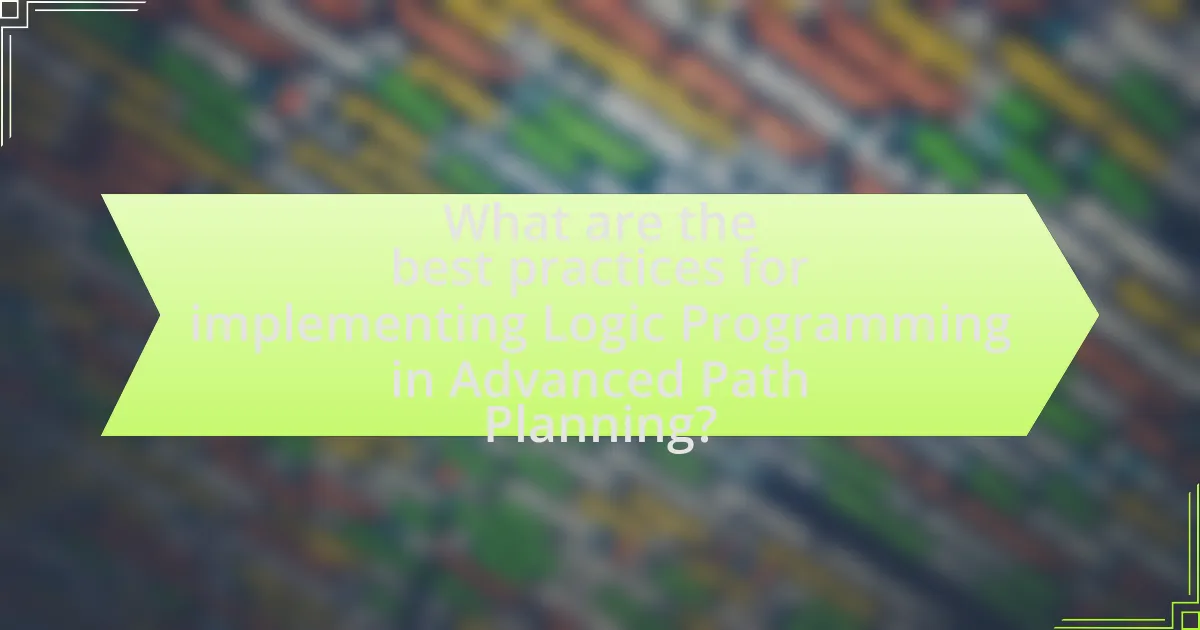
What are the best practices for implementing Logic Programming in Advanced Path Planning?
The best practices for implementing Logic Programming in Advanced Path Planning include defining clear logical rules, utilizing efficient search algorithms, and ensuring modularity in code design. Clear logical rules help in accurately representing the environment and constraints, which is essential for effective pathfinding. Efficient search algorithms, such as A* or Dijkstra’s, optimize the pathfinding process by minimizing computational resources while ensuring optimal routes. Modularity in code design allows for easier updates and maintenance, facilitating the integration of new features or adjustments to existing logic. These practices enhance the reliability and performance of path planning systems in robotics.
How can developers effectively utilize Logic Programming for path planning?
Developers can effectively utilize Logic Programming for path planning by employing declarative problem-solving techniques that allow for the specification of constraints and goals without detailing the control flow. This approach enables the representation of complex environments and the relationships between various entities, facilitating the generation of optimal paths. For instance, Prolog, a prominent logic programming language, allows developers to define rules and facts about the environment, which can be queried to find feasible paths based on the defined constraints. Research has shown that using logic-based methods can improve the efficiency of pathfinding algorithms, as evidenced by studies demonstrating that logic programming can handle dynamic changes in the environment more effectively than traditional methods.
What common pitfalls should be avoided in Logic Programming for robotics?
Common pitfalls to avoid in Logic Programming for robotics include neglecting the complexity of the problem domain, which can lead to inefficient algorithms. Additionally, failing to account for real-time constraints can result in systems that are unable to respond promptly to dynamic environments. Another significant pitfall is the over-reliance on logical inference without incorporating probabilistic reasoning, which is crucial for handling uncertainty in robotic applications. Lastly, not properly managing resources, such as memory and processing power, can hinder the performance of robotic systems. These pitfalls can severely impact the effectiveness and reliability of robotic path planning and decision-making processes.
How can testing and validation improve path planning outcomes?
Testing and validation enhance path planning outcomes by ensuring algorithms function correctly in diverse scenarios. Through systematic testing, developers can identify and rectify errors, leading to more reliable navigation solutions. Validation processes, such as simulation and real-world trials, confirm that the path planning algorithms meet performance criteria, including efficiency and safety. For instance, a study by Kuffner and LaValle demonstrated that rigorous testing of motion planning algorithms significantly reduced collision rates in robotic applications, thereby improving overall operational effectiveness.
What resources are available for learning about Logic Programming in Robotics?
Resources for learning about Logic Programming in Robotics include academic textbooks, online courses, research papers, and specialized workshops. Notable textbooks such as “Logic Programming for Artificial Intelligence” by Michael Gelfond and Vladimir Lifschitz provide foundational knowledge. Online platforms like Coursera and edX offer courses specifically focused on logic programming applications in robotics. Research papers, such as “Logic Programming in Robotics: A Survey” by A. K. Gupta and S. K. Gupta, published in the Journal of Robotics, detail current methodologies and advancements. Additionally, workshops at conferences like the International Conference on Robotics and Automation (ICRA) often feature sessions on logic programming techniques in robotic systems.
What are the best online courses or tutorials for Logic Programming?
The best online courses for Logic Programming include “Learn Prolog Now!” and “Introduction to Logic Programming” on platforms like Coursera and edX. “Learn Prolog Now!” offers a comprehensive introduction to Prolog, a key language in logic programming, while “Introduction to Logic Programming” provides foundational knowledge and practical applications. These courses are well-structured, featuring interactive exercises and real-world examples, making them suitable for learners at various levels.
How can community forums and groups assist in learning and troubleshooting?
Community forums and groups assist in learning and troubleshooting by providing a platform for knowledge sharing and collaborative problem-solving among individuals with similar interests in logic programming and robotics. These forums enable users to ask specific questions, receive diverse perspectives, and access a wealth of shared resources, such as tutorials, code snippets, and troubleshooting tips. For instance, platforms like Stack Overflow and specialized robotics forums have extensive archives of discussions that can help users resolve common issues encountered in advanced path planning algorithms. Additionally, the collective expertise of community members often leads to quicker identification of solutions and innovative approaches to complex problems, enhancing the overall learning experience.
